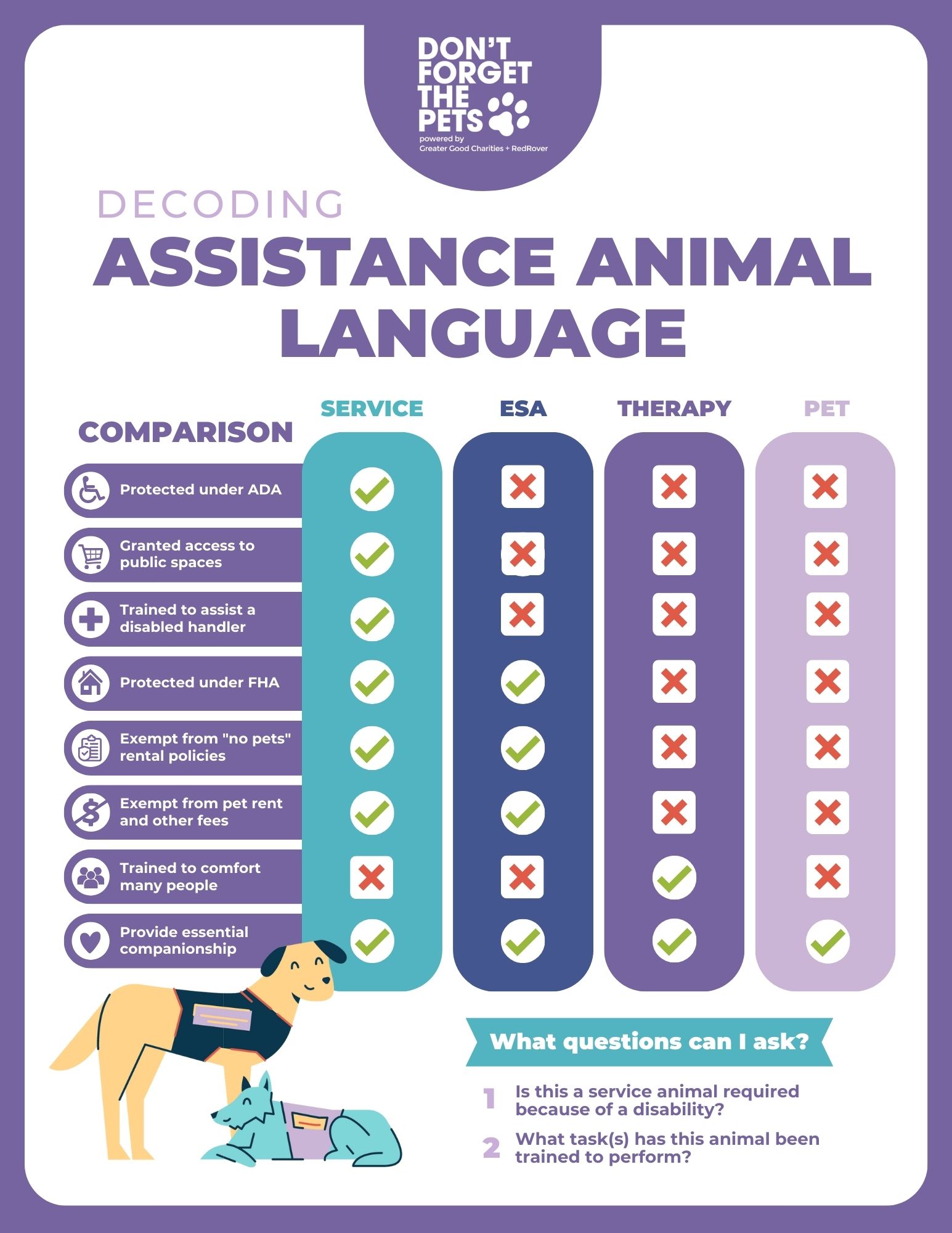Everything you need to know about service animals, ESA's, therapy animals, and pets.
Animals work with humans in an endless number of ways. Therapy animals, service animals, emotional support animals, and pets all fulfill unique and essential roles in the lives of humans; but the tasks they perform and the legal protections offered to them are distinct. Navigating these distinctions can be challenging, particularly for those who work in social services. However, it is vital that advocates take time to understand the roles that animals play in their clients’ lives in order to connect them to appropriate resources and provide them with quality, holistic care.
Service Animals
The Americans with Disabilities Act (ADA) defines a service animal as an animal who has been trained to perform specific tasks for an individual with a disability.¹ The task(s) that the animal performs must be directly related to the handler’s disability and may include things like retrieving dropped items, detecting an allergen, alerting to a seizure, or reminding a person to take medication.
The ADA requires that all businesses, government agencies, and non-profit organizations make reasonable accommodations for service animals and their handlers. In general, these animals must be allowed entry into all areas where the public is allowed, including restaurants, grocery stores, hotels, public transportation, homeless shelters, domestic violence shelters, and hospitals. They are also exempt from pet fees and may not be restricted to only “pet-friendly” spaces.¹
It is important to note that there is currently no national registry or licensing requirement for service animals. Businesses may not ask individuals with service animals to produce documentation or proof of service animal status and cannot require them to wear a special vest, ID tag, or harness.
To help determine if an animal is a service animal, staff may ask only two specific questions:
“Is this a service animal required because of a disability?”
“What task(s) has this animal been trained to perform?”
Staff may not ask for the animal to demonstrate the task, nor may they inquire about the nature of the individual’s disability.¹
Under Title II and III of the ADA, service animals are limited to dogs.² However, entities must also attempt to make reasonable accommodations for specially trained miniature horses that fit within established size and weight requirements.⁴
The ADA does not restrict the breeds of dogs that may be used as service animals, and it is unlawful to refuse access to a service dog based solely on its breed. Additionally, jurisdictions with breed-specific legislation must make exceptions for service dogs.¹
Emotional Support Animals
Emotional Support Animals (ESAs) are animals who provide support and companionship to their owners to help alleviate symptoms of a psychological disability, such as anxiety, depression, phobias, or post-traumatic stress. Unlike service animals, ESAs are not trained to perform specific tasks. Instead, their owners rely on their presence alone to provide therapeutic effects. ESAs are not included under the ADA and are not granted unlimited access to public spaces. However, ESAs are considered “assistance animals” under the Fair Housing Act (FHA) which requires housing providers to offer “reasonable accommodations” to ESAs and their owners.⁵ Property owners may not deny residence to owners of emotional support animals (even in buildings that don’t allow pets) and may not charge additional fees like pet rent or deposits.
The FHA and state fair housing laws also cover most non-profit housing, shelters, and transitional housing programs.¹² Under Section 504 of the Rehabilitation Act of 1973, any program that receives federal funding or financial assistance is prohibited from disability discrimination.¹³ Preventing owners of service animals or ESAs from accessing shelter or other program services could be considered discrimination under Section 504 and may result in an investigation by the U.S. Department of Housing and Urban Development (HUD) and a civil penalty of up to $11,000.¹⁴
Owners of ESAs may be asked to produce documentation of their animal’s ESA status. This documentation typically comes in the form of a letter from a physician, psychiatrist, or other mental health professional. The letter should clearly state that the patient has been diagnosed with a disability and that the animal is part of their treatment plan.⁶ There is currently no restriction on the species or breeds of animals that can be certified as emotional support animals.
It’s important to note that the ADA makes a distinction between ESAs and psychiatric service dogs.¹ While both animals may help support owners with psychological disabilities, psychiatric service dogs are trained to perform a specific task to help ease symptoms. For example, a psychiatric service dog may interrupt compulsive behaviors or repetitive self-harm, apply deep pressure therapy during a panic attack, or wake their handler from nightmares. As such, psychiatric service dogs are considered service animals and are protected under the ADA.
Therapy Animals
Therapy animals can often be found in hospitals, nursing homes, courtrooms, and schools, working alongside a handler to provide comfort and affection to the public. Animal-assisted therapy (sometimes referred to as “animal-assisted intervention”) may lessen perceptions of pain, decrease anxiety, and alleviate symptoms of depression. For those working in social services, having the support of a trained therapy animal may assist clients in trauma recovery.¹¹
While therapy animals typically receive rigorous training to ensure that they can behave appropriately in a variety of settings, they are not trained to perform specific assistance tasks and are not protected under the ADA. Therapy animals are not considered service animals and do not have the same legal right to occupy public spaces. Before entering a facility to provide therapeutic services, the handler must obtain permission from the business or building owner.
Therapy animals are also not considered “assistance animals” under the FHA, and are subject to the same rental policies and restrictions as other pets. Property owners with “no pets” policies may also deny residence to therapy animals.
Pets
More than 70% of U.S. households have pets (sometimes referred to as “companion animals”), and the social support they offer has been shown to improve both the physical and mental health of their owners.⁷ The physiological benefits of pet ownership include lower blood pressure, increased physical activity, and reduced risk of death due to cardiovascular disease. Pet owners also report decreased loneliness, stress, anxiety, and depression, and stronger feelings of self-worth.⁷
While pet ownership is not a protected status under the ADA or FHA, pet-inclusive sheltering and housing policies can have a dramatic impact on communities. Pets encourage residents to connect with one another and foster supportive relationships. Among both pet and non-pet owners, 71% of residents surveyed said that pets can help bring people together and build a stronger sense of community.⁷ Among the unhoused population, animal companionship is particularly fortifying and may encourage individuals to achieve sobriety, avoid incarceration, or leave abusive relationships.¹⁰ Individuals may avoid substance use and other high-risk behaviors out of a sense of responsibility to care for their pets.⁸ In a 2019 survey by the Urban Resource Institute and National Domestic Violence Hotline, 97% of respondents said that keeping their pets with them was an important factor in determining whether to seek shelter from domestic abuse.⁹
For those working in social services, adopting pet-inclusive policies can help foster trust and dramatically improve outcomes for residents. Are you interested in taking steps to make your organization pet-inclusive? Reach out to RedRover Community Outreach Coordinator, Danielle at dworks@redrover.org for more information.
¹ U.S. Department of Justice, “Frequently Asked Questions about Service Animals and the ADA”. 2015. https://www.ada.gov/regs2010/service_animal_qa.html
² Jacquie Brennan and Vinh Nguyen, “Service Animals and Emotional Support Animals”, Southwest ADA Center. 2014. https://adata.org/guide/service-animals-and-emotional-support-animals
³ Mid-Atlantic ADA Center, “Information, Guidance and Training on the Americans with Disabilities Act”, ADA National Network. 2017. https://adata.org/sites/adata.org/files/files/Service_Animals_final2017.pdf
⁴ U.S. Department of Justice, “ADA Requirements: Service Animals”, February 2020. https://www.ada.gov/service_animals_2010.htm
⁵ U.S. Department of Housing and Urban Development, “Assistance Animals”. https://www.hud.gov/program_offices/fair_housing_equal_opp/assistance_animals
⁶ U.S. Department of Housing and Urban Development, “Notice FHEO-2020-01: Assessing a Person’s Request to Have an Animal as a Reasonable Accommodation Under the Fair Housing Act”, Office of Fair Housing and Equal Opportunity. January 28, 2020. https://www.hud.gov/sites/dfiles/PA/documents/HUDAsstAnimalNC1-28-2020.pdf
⁷ Michelson Found Animals Foundation and The Human Animal Bond Research Institute, “2021 Pet-Inclusive Housing Report”. 2021. https://www.foundanimals.org/pets-and-housing/2021-pet-inclusive-housing-report/
⁸ Maddie’s Fund and The University of Tennessee Knoxville, “Access to Veterinary Care: Barriers, Current Practices, and Public Policy”. December 18, 2017. https://trace.tennessee.edu/cgi/viewcontent.cgi?article=1016&context=utk_smalpubs
⁹ Urban Resource Institute and the National Domestic Violence Hotline, “PALS Report and Survey: Domestic Violence and Pets: Breaking Barriers to Safety and Healing”. 2019. https://urinyc.org/palsreport/
¹⁰ National Alliance to End Homelessness and PetSmart Charities, “Improving Outcomes in Homelessness: Keeping People and Pets Together”. https://endhomelessness.org/wp-content/uploads/2020/03/Keeping-People-and-Pets-Together-031220.pdf
¹¹ Pet Partners, “Empirical Support for Therapy Animal Interventions”. https://petpartners.org/wp-content/uploads/2021/08/Benefits-of-the-Human-Animal-Bond-FINAL-v2.pdf
¹² Fair Housing Partners of Washington State, “A Guide to Fair Housing for Nonprofit Housing and Shelter Providers”. August 2014. https://www.seattle.gov/documents/Departments/CivilRights/FH-Guide-Nonprofits_Shelters.pdf
¹³ U.S. Department of Housing and Urban Development, “Section 504: Frequently Asked Questions”. https://www.hud.gov/program_offices/fair_housing_equal_opp/disabilities/sect504faq#_Reasonable_Accommodation
¹⁴ U.S. Department of Housing and Urban Development,”HUD’s Title VIII Fair Housing Complaint Process”. https://www.hud.gov/sites/documents/23536_COMPLAINT-PROCESS.PDF




